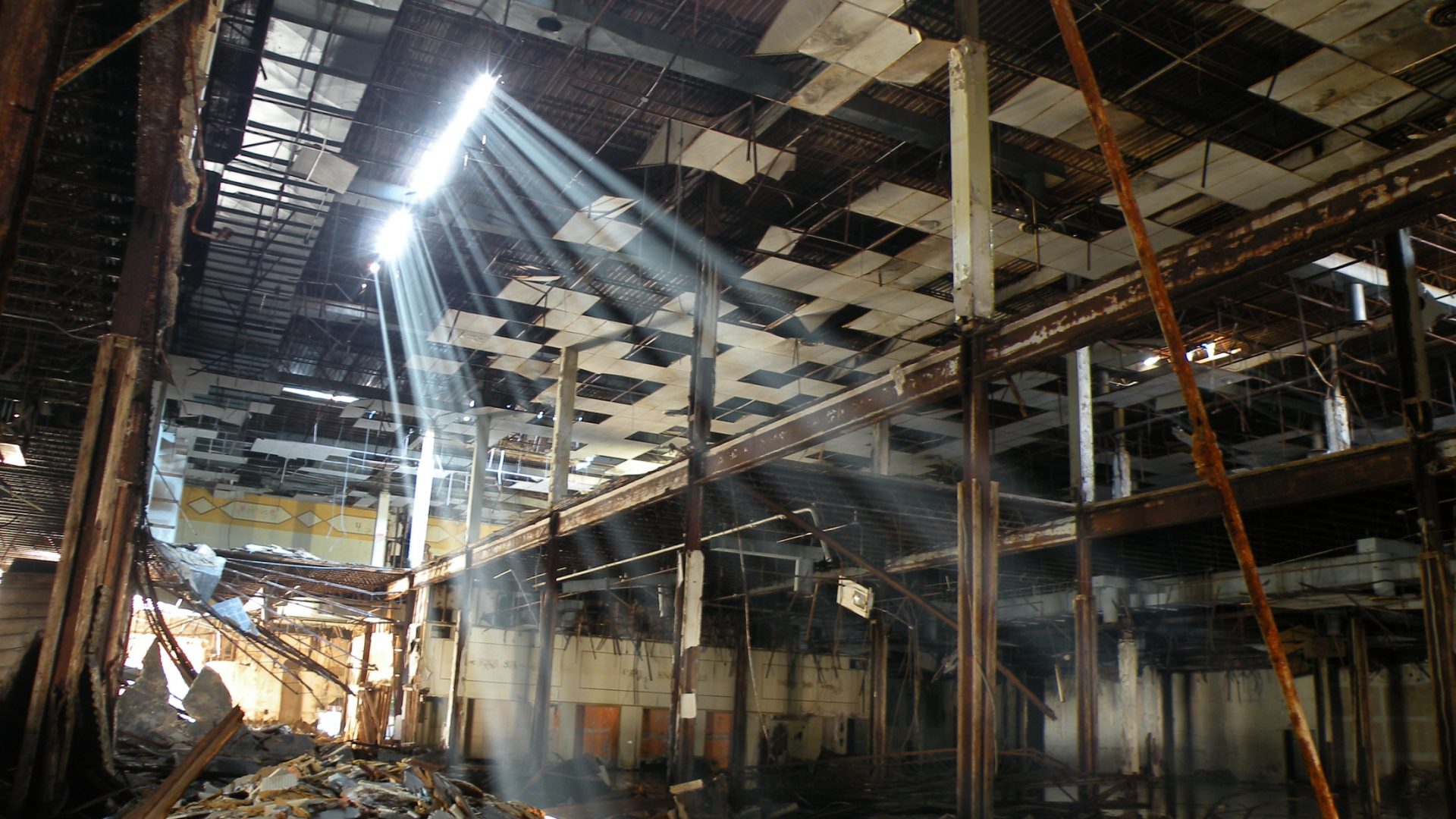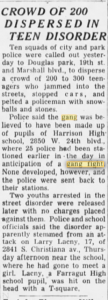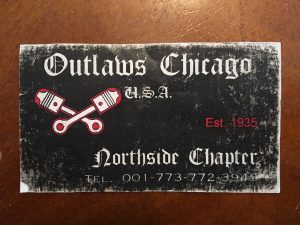| Origins | Settled c. 1827 and annexed c. 1889 |
|---|---|
| Area | West Side |
| Boundaries | Ogden Avenue on the north, railroad tracked along 33rd Street on the south, Western Avenue on the east, railroad tracks on the west; Little Village: Ogden Avenue on the north, railroad tracked along 33rd Street on the south, Kedzie Avenue on the east, railroad tracks on the west. |
| Gangs founded | Two Six, Sin City Boys, Ridgeway Lords, Gaylords, Ridgeway Boys, Party Gents, |
| Gangs headquartered | Two Six, Latin Kings, |
This area was first settled in 1827 as the largest part of the Lawndale-Crawford settlement; from there many farms were built in the area.
In the year 1863 the expansion of the Chicago, Burlington and Quincy railroads caused Lawndale and Crawford to become separate communities with Lawndale on the north and this area became Crawford. After the Great Chicago Fire of 1871 many German, Irish, Dutch and Scottish immigrants fled to this area to start a new life far outside from the woes of the inner city.
In 1873 McCormick Reaper Works built their brand-new facility in South Lawndale; this made the area even more attractive to immigrants looking for housing near employment. The area was annexed in 1889 during the major annexation plan of 1889 and the area was renamed “South Lawndale.”
The area remained mostly farmland until the 1900s decade when Western Electric’s Hawthorne Works was built in nearby Cicero and the Sears Roebuck tower was constructed in neighboring North Lawndale. Now new subdivisions were laid out while Czechoslovakians began moving in large numbers to the community as Irish, Dutch and Scottish began moving out.
In the 1940s decade the Czechs were joined by a large influx of Polish immigrants that were lured in by the many manufacturing jobs in the area and now Germans, Czechs and Polish dominated the area.
In the year 1942 the Chicago Housing Authority built the Lawndale Gardens public housing project over the border in the Marshall Square neighborhood in order to house impoverished white residents that were employed to help with the war effort but too poor to afford housing. These projects were built between 25th and 26th Streets and between California Avenue and Washtenaw Avenue.
In the early 1950s a smaller influx of African Americans moved into the neighborhood especially in the Lawndale Gardens projects which sparked some outrage in the community.
In the year 1950 the Outlaws Motorcycle Club that we know of today, opened their notorious club house/garage in Little Village at 25th and Rockwell. I don’t know the whole exact story but some young men in the neighborhood were bothered by this and formed their own club to battle the Outlaws called the “Gaylords” in that same year of 1950 at 24th and Whipple. I can imagine it was because the Outlaws were viewed as outsiders and part of an undesirable element for many of the people in this community. It was at this time when Outlaws began to become a rowdy group.
One brawl between the Outlaws and Gaylords made the newspaper in March of 1954. The Gaylords eventually dominated a very large area from about 21st Street to 26th Street and also in Harrison High School by the late 1950s. The Outlaws MC did not claim territory they just roamed wherever they pleased and did not care about any GayLord turf which caused more animosity.
In the 1950s decade the Outlaws and Gaylords ran Little Village and the two gangs clashed bitterly. Any other gangs were just small greaser clubs in comparison to these two larger forces.
In the year 1962, Mexican families began to settle in Little Village for the first time. As the families arrived there was some objection to their presence. Mexican families and youths were bullied and beaten by greasers to the point where Mexican youths stood up to it and the first Mexican gang in Little Village was created. In 1962, the Marshall Boulevard Kings or “MarKings” were formed at 24th and Marshall Boulevard. This gang of Mexican youths fought white greaser clubs tooth and nail and soon spread into popularity as they claimed territory at 24th and Marshall Boulevard “The Boulevards.” This territory was right outside Harrison High School and the Spry School across the street which helped young Mexican youths get to and from school safely, especially since the Gaylords ran Harrison High School. Other Mexican youths joined white gangs like the 26th Street Jokers, 23rd Street Boys or Supreme Clique instead of starting any other Mexican based street gangs. From my understanding these groups did not clash with the MarKings and were allies against the Gaylords.
Newly arriving Mexican youths that came into Little Village between the year 1962-1965 can recall how crazy the Outlaws and Gaylords were as the earlies Hispanic gang members had to fight these guys. The earliest Mexican gangs would learn a lot about gangbanging from these two groups which became a passed down trait over the generations for gangs in Little Village.
In the year 1966, the Latin Kings street gang leader from Wicker Park visited the MarKings and discovered they had something in common. They had the same symbols and both groups dealt with bullying white gangs. The leader of the Latin Kings proposed for these MarKings and their allies to come together. The meeting took place, and the Latin Kings were born at Marshall and 24th creating the infamous “Boulevards.” Now all MarKings, and most of the 23rd Street Boys, Jokers and Supreme Clique became Latin Kings and they ran the Boulevards. Many of the original Latin Kings in Little Village were white since the demographic in the area was majority white in 1966.
The Gaylords left this neighborhood by 1966 as members joined the military as soon as the Vietnam war started, many others partook in white flight and moved out of the area.
The Outlaws Motorcycle Club changed direction and became a club for older men and took their focus away from brawling with street gangs in the streets.
In the year 1966, Mexican and Puerto Rican people displaced from the University of Illinois at Chicago campus construction and Lincoln Park urban renewal programs came to Little Village and Marshall Square as a lot more white families moved out with a greater intensity. As these families moved in gangs from these neighborhoods followed like Artistics, Satan Disciples, Harrison Gents and Morgan Deuces. This is when Little Village groups like Sin City Boys and Ridgeway Lords formed to fight against these groups in 1966.
In the year 1966, the Ridgeway Lords took formation at 31st and Ridgeway as they began to dominate more of the western part of the community in the K-Town area. Latin Kings and Ridgeway Lords became good friends that ruled the neighborhood by the late 60s. The Sin City Boys formed in 1966 and from my understanding they didn’t get along with Latin Kings and Ridgeway Lords right away, they would especially have a harsh rivalry with Latin Kings in years to come. The Ridgeway Lords, like Latin Kings were a hard core street gang with serious bangers.
Gangs of Little Village clashed with Marshall Square gangs after Satan Disciples, Artistics and Morgan Deuces arrived in those borders. Satan Disciples clashed heavily with Latin Kings as they now battled for 24th Street.
By the end of the decade “white flight” increased rapidly as more Mexican families moved into the area. Lack of employment at local manufacturing jobs made the area less attractive to middle class whites. Czechs, Polish and German residents began to evacuate to the suburbs. As the white residents left, the meaning behind Little Village changed into a new identity as “La Villita” or Little Village became the new identity. The loss of manufacturing jobs only became worse in the 1970s as many Mexicans in the area fell into poverty.
In the year 1970, the Two Six gang formed in this community that battled with Ridgeway Lords and Latin Kings. The Two Sixs were not a big group in the early 70s and many never even heard of Two Six because they did not have symbols, colors or sweaters. They moved more as a clique rather than as a gang.
Also in the year 1970, the Villa Lobos migrated here from Pilsen. At first they were a small group on 26th Street in the early and mid-70s.
The Latin Kings and Ridgeway Lords dominated Little Village in the second half of the 60s and almost all of the 70s. There were several smaller gangs in the neighborhood at the time but these two were, by far, the largest.
The drug trade first began in this neighborhood in the early 1970s and by the mid-1970s it was little more prevalent but there were no major drug wars. Gangs were still all about partying and having a good time with gangs fights but not drug wars.
During the bi-centennial year of 1976, the Little Village gang territories shifted greatly as new gangs arrived and old gangs grew larger. The Villa Lobos became very popular in 1976 and opened much more territory, now they became well known in Little Village. The Two Two Boys and Kents formed in Marshall Square that rivaled many Little Village gangs. Migrating gangs like Ambrose and Latin Counts moved into the area in 1976 that caused a stir. Ambrose moved right onto 26th Street but Latin Counts technically moved into the Lawndale projects that are in Marshall Square. Latin Counts and Ambrose battled Latin Kings and Ridgeway Lords. Late in that year Latin Kings started a war with the Ridgeway Lords after killing one of their members in Trumbull Park.
The Two Six gang was still not very known heading into 1977 but after the group initiated the Ayala boys and “Sweet Wine” into their group, they became connected to the Mexican drug cartels. Now Two Six members had lots of guns to fight Latin Kings and Ridgeway Lords. Two Six then approached the Harrison Gents and Villa Lobos asking them to join. Harrison Gents said yes, and the Villa Lobos said no. The Villa Lobos then got brought into a war with Two Six because their refusal was not accepted.
Now that Ridgeway Lords were at war with Latin Kings it made them for vulnerable to attack from other gangs. This is when Two Six encroached upon the Ridgeway Lord’s coveted K-Town territory and took the majority of it from the RLs. This is how K-Town Two Six and Darkside Two Six were established.
By the early 1980s Two Six began growing in popularity while Ridgeway Lords were losing turf. The Ridgeway Lords made a decision to ally with Two Six and Satan Disciples so they could stay afloat.
By the mid-80s drug wars grew in this community as shootings and killings became common place. The main rivalry was not between Two Six and Latin Kings as Ridgeway Lords shrunk more. Ambrose and Latin Counts left the area during these years.
In the year 1988, Two Six started a war with Ridgeway Lords after killing a high ranking RL, at this point RLs shrunk more and withdrew from the community leaving just a small group of them left. Two Six and Satan Disciples were engaged in a violent war during this time but Two Six could not be taken apart by the late 80s and instead grew tremendously and by the late 80s Two Six and Latin Kings ruled Little Village. Smaller gangs began to decline.
By the late 80s, shootings were almost daily and smaller gangs were losing ground as Latin Kings and Two Six went back and forth while both groups were dealing drugs heavily and killing for it. This community had now become extremely violent.
By the mid-1990s it was all about drug turf between Two Six and Latin Kings as all other gangs left the area. Sin City Boys, Party Gents, Stone Kents, Ridgeway Lords and Villa Lobos closed their territories in order to not get put in the middle of the cross fire.
The 1970s, 1980s and 1990s saw the most violent years on the streets of Little Village mostly due to the back and forth violence between Two Six and Latin Kings as they continued to hit each other back again and again. Little Village would often be regarded as one of the more dangerous neighborhoods in Chicago. In the 21st century the violence has toned down some, but this is still an area plagued with crime and is the poorest Mexican community in the city. Eventually Two Sixs and Latin Kings suppressed other gangs to the point where they really can’t claim any ownership of territory on these streets.
Little Village is the hub of Chicago Mexican culture and is proud of their heritage. It is a neighborhood with great restaurants and hardworking people even though gang violence is heavy in these streets. There is no need to fear passing through or shopping in this community because gang members are not trying to cause trouble with law abiding citizens for the most part. Mainly it is just gang against gang violence.
Little Village is the birthplace of the south side Latin Kings, Two Six, Party Gents, Sin City Boys and Ridgeway Lords.
Party Gents Established 1980-mid 90s
26th & Millard Established 1980-mid 90s
Ridgeway Boys 90s, 2000s
Ridgeway from 25th to 27th (Bordertown) 90s, 2000s
Ambrose Established 1976-1985
26th & Kolin Established 1976-1985
Harrison Gents Established 1966-1977
26th Street somewhere Established 1966-1977
Gaylords Established 1950-1966
24th & Whipple Established 1950-1966
21st to 26th, Whipple to Marshall Blvd Established 1950-1966
Party Players 90s
Homan from 27th to 28th 90s
Latin Kings Established 1966-present years
23rd & Spaulding
23rd & Whipple
24th & Christiana
24th & Drake (Chi Town Two Four)
24th & Marshall (The Boulevards) Established 1962 as Marshall Kings, 1966 as Latin Kings
Millard from 24th to 27th
24th & Sawyer
St. Louis from 24th to 25th (Coulter Side, Coulter Latin Kings)
Trumbull from 24th to 25th (Two Four Trumbull)
25th & Avers
25th & California (Lawndale projects) Established circa 1985 after Latin Counts left
25th & Coulter (Coulter Latin Kings)
25th & Spaulding (Spanish Harlem)
Drake from 25th to 27th
27th & Homan
Lawndale from 25th to 28th (Lawndale Latin Kings)
30th & Sawyer (Redrum City)
30th & Trumbull
31st & Drake (Drake Side)
30th to 31st, Kedzie to Sacramento (Redrum City)
24th to 26th, Kedzie to Christiana (Spanish Harlem)
21st to 31st, Lawndale to California (Chi Town)
26th to 25th, Hamlin to Central Park (Lawndale Latin Kings)
Simon City Royals
28th & Kildare 90s
Two Six Established 1970-present years
23rd to 33rd, to Hamlin to Pulaski (Chi Town Two Six) Established 1977-present years
24th to 33rd, Kostner to Pulaski (K-Town Two Six) Established 1977-present years
24th & Karlov (Two Four Karlov)
25th & Keeler (Two Five Keeler)
30th & Lawndale
26th & Sawyer Established 1970-1977
24th from Millard to Lawndale
24th & Sawyer
26th & St. Louis
27th from Keeler to Tripp
Satan Disciples 80s
27th & Komenski 80s
Latin Brothers Established 1970-1971
26th & Lawndale Established 1970-1971
Sin City Boys Established 1966-1992
27th & Ridgeway Established 1966-1992
27th & Springfield
Spanish Gangster Disciples 80s, 90s
26th & Tripp 80s, 90s
Stone Kents 80s
27th & Whipple (La Villita Park as Stone Kents) 80s
21st to 24th, Marshall to Kedzie 80s
23rd & Trumbull 80s
Villa Lobos Established 1970-present years
26th & St. Louis Established 1970-1976
26th & Central Park Ave Established 1976
24th & Drake Established 1976
23rd & St. Louis Established 1976
23rd & Ridgeway Established 1976-present years
30th & Drake Established 1976
Ridgeway Lords Established 1966-1994
31st & Ridgeway Established 1966
Lawndale to Ridgeway on 24th
Ogden to 33rd, Kilbourn to Pulaski (K-Town) Established 1966-1977
YLO Disciples 90s-present years
32nd & Lawndale 90s-present years



